Cisco Certification Exam Prep Materials
Cisco CCNA Exam Prep Material Download
Cisco CCT Exam Prep Material Download
- Cisco 010-151 Dumps PDF
- Cisco 100-490 Dumps PDF
- Cisco 100-890 Dumps PDF
- Tips: Beginning February 10, the CCT Certification 500-150 FLDTEC v1.0 exam will replace the 100-490, 010-151, and 100-890 exams.
Cisco CyberOps Exam Prep Material Download
Cisco DevNet Exam Prep Material Download
Cisco CCNP Exam Prep Material Download
- Cisco 300-410 Dumps PDF
- Cisco 300-415 Dumps PDF
- Cisco 300-420 Dumps PDF
- Cisco 300-425 Dumps PDF
- Cisco 300-430 Dumps PDF
- Cisco 300-435 Dumps PDF
- Cisco 300-440 Dumps PDF
- Cisco 300-510 Dumps PDF
- Cisco 300-515 Dumps PDF
- Cisco 300-535 Dumps PDF
- Cisco 300-610 Dumps PDF
- Cisco 300-615 Dumps PDF
- Cisco 300-620 Dumps PDF
- Cisco 300-630 Dumps PDF
- Cisco 300-635 Dumps PDF
- Cisco 300-710 Dumps PDF
- Cisco 300-715 Dumps PDF
- Cisco 300-720 Dumps PDF
- Cisco 300-725 Dumps PDF
- Cisco 300-730 Dumps PDF
- Cisco 300-735 Dumps PDF
- Cisco 300-810 Dumps PDF
- Cisco 300-815 Dumps PDF
- Cisco 300-820 Dumps PDF
- Cisco 300-835 Dumps PDF
Cisco CCIE Exam Prep Material Download
- Cisco 350-401 Dumps PDF
- Cisco 350-501 Dumps PDF
- Cisco 350-601 Dumps PDF
- Cisco 350-701 Dumps PDF
- Cisco 350-801 Dumps PDF
Cisco CCDE Exam Prep Material Download
Cisco Other Exam Prep Material Download
- Cisco 500-052 Dumps PDF
- Cisco 500-210 Dumps PDF
- Cisco 500-220 Dumps PDF
- Cisco 500-420 Dumps PDF
- Cisco 500-442 Dumps PDF
- Cisco 500-444 Dumps PDF
- Cisco 500-470 Dumps PDF
- Cisco 500-490 Dumps PDF
- Cisco 500-560 Dumps PDF
- Cisco 500-710 Dumps PDF
- Cisco 700-150 Dumps PDF
- Cisco 700-750 Dumps PDF
- Cisco 700-760 Dumps PDF
- Cisco 700-765 Dumps PDF
- Cisco 700-805 Dumps PDF
- Cisco 700-821 Dumps PDF
- Cisco 700-826 Dumps PDF
- Cisco 700-846 Dumps PDF
- Cisco 700-905 Dumps PDF
- Cisco 820-605 Dumps PDF
Fortinet Exam Dumps
fortinet nse4_fgt-6.4 dumps (pdf + vce)
fortinet nse4_fgt-6.2 dumps (pdf + vce)
fortinet nse5_faz-6.4 dumps (pdf + vce)
fortinet nse5_faz-6.2 dumps (pdf + vce)
fortinet nse5_fct-6.2 dumps (pdf + vce)
fortinet nse5_fmg-6.4 dumps (pdf + vce)
fortinet nse5_fmg-6.2 dumps (pdf + vce)
fortinet nse6_fml-6.2 dumps (pdf + vce)
fortinet nse6_fnc-8.5 dumps (pdf + vce)
fortinet nse7_efw-6.4 dumps (pdf + vce)
fortinet nse7_efw-6.2 dumps (pdf + vce)
fortinet nse7_sac-6.2 dumps (pdf + vce)
fortinet nse7_sdw-6.4 dumps (pdf + vce)
fortinet nse8_811 dumps (pdf + vce)
Valid Microsoft AZ-204 questions shared by Pass4itsure for helping to pass the Microsoft AZ-204 exam! Get the newest Pass4itsure Microsoft AZ-204 exam dumps with VCE and PDF here: https://www.pass4itsure.com/az-204.html (245 Q&As Dumps).
[Free PDF] Microsoft AZ-204 pdf https://drive.google.com/file/d/1e8HJgdwW1CDnelD-cU0rFmJYxtx4YTMg/view?usp=sharing
Suitable for AZ-204 complete Microsoft learning pathway
The content is rich and diverse, and learning will not become boring. You can learn in multiple ways through the Microsoft AZ-204 exam.
- Download
- Answer practice questions, the actual Microsoft AZ-204 test
Microsoft AZ-204 Developing Solutions for Microsoft Azure
Free Microsoft AZ-204 dumps download
[PDF] Free Microsoft AZ-204 dumps pdf download https://drive.google.com/file/d/1e8HJgdwW1CDnelD-cU0rFmJYxtx4YTMg/view?usp=sharing
Pass4itsure offers the latest Microsoft AZ-204 practice test free of charge 1-13
QUESTION 1
Note: This question is part of a series of questions that present the same scenario. Each question in the series contains
a unique solution. Determine whether the solution meets the stated goals.
You are developing and deploying several ASP.NET web applications to Azure App Service. You plan to save session
state information and HTML output. You must use a storage mechanism with the following requirements:
1.
Share session state across all ASP.NET web applications.
2.
Support controlled, concurrent access to the same session state data for multiple readers and a single writer.
3.
Save full HTTP responses for concurrent requests.
You need to store the information.
Proposed Solution: Deploy and configure Azure Cache for Redis. Update the web applications.
Does the solution meet the goal?
A. Yes
B. No
Correct Answer: A
The session state provider for Azure Cache for Redis enables you to share session information between different
instances of an ASP.NET web application.
The same connection can be used by multiple concurrent threads.
Redis supports both read and write operations.
The output cache provider for Azure Cache for Redis enables you to save the HTTP responses generated by an
ASP.NET web application.
Note: Using the Azure portal, you can also configure the eviction policy of the cache, and control access to the cache by
adding users to the roles provided. These roles, which define the operations that members can perform, include Owner,
Contributor, and Reader. For example, members of the Owner role have complete control over the cache (including
security) and its contents, members of the Contributor role can read and write information in the cache, and members of
the
Reader role can only retrieve data from the cache.
Reference: https://docs.microsoft.com/en-us/azure/architecture/best-practices/caching
QUESTION 2
You need to secure the Shipping Logic App. What should you use?
A. Azure App Service Environment (ASE)
B. Integration Service Environment (ISE)
C. VNet service endpoint
D. Azure AD B2B integration
Correct Answer: B
Scenario: The Shipping Logic App requires secure resources to the corporate VNet and use dedicated storage
resources with a fixed costing model.
You can access to Azure Virtual Network resources from Azure Logic Apps by using integration service environments
(ISEs).
Sometimes, your logic apps and integration accounts need access to secured resources, such as virtual machines
(VMs) and other systems or services, that are inside an Azure virtual network. To set up this access, you can create an
integration service environment (ISE) where you can run your logic apps and create your integration accounts.
Reference: https://docs.microsoft.com/en-us/azure/logic-apps/connect-virtual-network-vnet-isolated-environmentoverview
QUESTION 3
You are developing an application that uses Azure Blob storage.
The application must read the transaction logs of all the changes that occur to the blobs and the blob metadata in the
storage account for auditing purposes. The changes must be in the order in which they occurred, include only create,
update, delete, and copy operations and be retained for compliance reasons.
You need to process the transaction logs asynchronously.
What should you do?
A. Process all Azure Blob storage events by using Azure Event Grid with a subscriber Azure Function app.
B. Enable the change feed on the storage account and process all changes for available events.
C. Process all Azure Storage Analytics logs for successful blob events.
D. Use the Azure Monitor HTTP Data Collector API and scan the request body for successful blob events.
Correct Answer: B
Change feed support in Azure Blob Storage The purpose of the change feed is to provide transaction logs of all the
changes that occur to the blobs and the blob metadata in your storage account. The change feed provides ordered,
guaranteed, durable, immutable, read-only log of these changes. Client applications can read these logs at any time,
either in streaming or in batch mode. The change feed enables you to build efficient and scalable solutions that process
change events that occur in your Blob Storage account at a low cost.
Reference: https://docs.microsoft.com/en-us/azure/storage/blobs/storage-blob-change-feed
QUESTION 4
HOTSPOT
You need to update the APIs to resolve the testing error.
How should you complete the Azure CLI command? To answer, select the appropriate options in the answer area.
NOTE: Each correct selection is worth one point.
Hot Area:
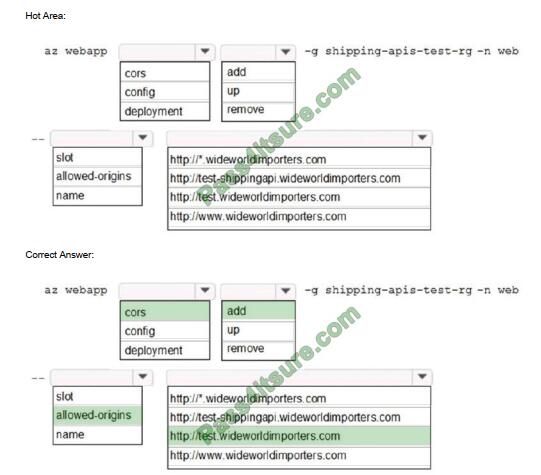
Enable Cross-Origin Resource Sharing (CORS) on your Azure App Service Web App.
Enter the full URL of the site you want to allow to access your WEB API or * to allow all domains.
Box 1: cors
Box 2: add
Box 3: allowed-origins
Box 4: http://testwideworldimporters.com/
References:
http://donovanbrown.com/post/How-to-clear-No-Access-Control-Allow-Origin-header-error-with-Azure-App-Service
QUESTION 5
Note: This question is part of a series of questions that present the same scenario. Each question in the series contains
a unique solution that might meet the stated goals. Some question sets might have more than one correct solution,
while others might not have a correct solution.
After you answer a question in this question, you will NOT be able to return to it. As a result, these questions will not
appear in the review screen.
Margie\\’s Travel is an international travel and bookings management service. The company is expanding into
restaurant bookings. You are tasked with implementing Azure Search for the restaurants listed in their solution.
You create the index in Azure Search.
You need to import the restaurant data into the Azure Search service by using the Azure Search .NET SDK.
Solution:
1.
Create a SearchIndexClient object to connect to the search index
2.
Create an IndexBatch that contains the documents which must be added.
3.
Call the Documents.Index method of the SearchIndexClient and pass the IndexBatch.
Does the solution meet the goal?
A. Yes
B. No
Correct Answer: A
1.
The index needs to be populated. To do this, we will need a SearchIndexClient. There are two ways to obtain one: by
constructing it, or by calling Indexes.GetClient on the SearchServiceClient. Here we will use the first method.
2.
Create the indexBatch with the documents
Something like:
var hotels = new Hotel[];
{
new Hotel()
{
HotelId = “3”,
BaseRate = 129.99,
Description = “Close to town hall and the river”
}
};
…
var batch = IndexBatch.Upload(hotels);
3.
The next step is to populate the newly-created index
Example:
var batch = IndexBatch.Upload(hotels);
try { indexClient.Documents.Index(batch); }
References: https://docs.microsoft.com/en-us/azure/search/search-howto-dotnet-sdk
QUESTION 6
HOTSPOT
You plan to deploy a new application to a Linux virtual machine (VM) that is hosted in Azure.
The entire VM must be secured at rest by using industry-standard encryption technology to address organizational
security and compliance requirements.
You need to configure Azure Disk Encryption for the VM.
How should you complete the Azure CLI commands? To answer, select the appropriate options in the answer area.
NOTE: Each correct selection is worth one point. Hot Area:
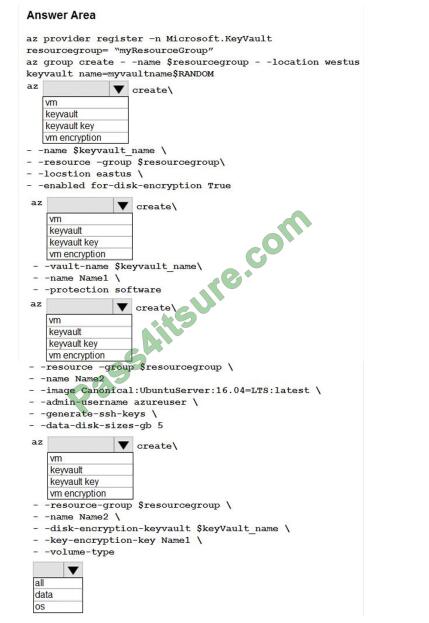
Correct Answer:
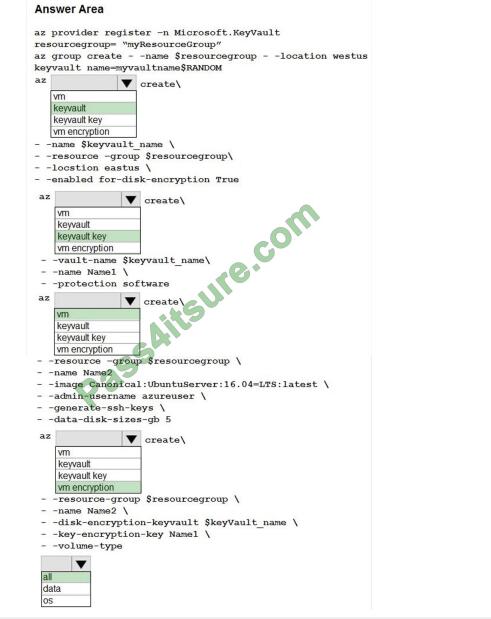
Box 1: keyvault
Create an Azure Key Vault with az keyvault create and enable the Key Vault for use with disk encryption. Specify a
unique Key Vault name for keyvault_name as follows:
keyvault_name=myvaultname$RANDOM
az keyvault create \
–name $keyvault_name \
–resource-group $resourcegroup \
–location eastus \
–enabled-for-disk-encryption True
Box 2: keyvault key
The Azure platform needs to be granted access to request the cryptographic keys when the VM boots to decrypt the
virtual disks. Create a cryptographic key in your Key Vault with az keyvault key create. The following example creates a
key
named myKey:
az keyvault key create \
–vault-name $keyvault_name \
–name myKey \
–protection software
Box 3: vm
Create a VM with az vm create. Only certain marketplace images support disk encryption. The following example
creates a VM named myVM using an Ubuntu 16.04 LTS image:
az vm create \
–resource-group $resourcegroup \
–name myVM \
–image Canonical:UbuntuServer:16.04-LTS:latest \
–admin-username azureuser \
–generate-ssh-keys \
Box 4: vm encryption
Encrypt your VM with az vm encryption enable:
az vm encryption enable \
–resource-group $resourcegroup \
–name myVM \
–disk-encryption-keyvault $keyvault_name \
–key-encryption-key myKey \
–volume-type all
Note: seems to an error in the question. Should have enable instead of create.
Box 5: all
Encrypt both data and operating system.
References:
https://docs.microsoft.com/bs-latn-ba/azure/virtual-machines/linux/encrypt-disks
QUESTION 7
HOTSPOT
You have an app that stores player scores for an online game. The app stores data in Azure tables using a class named
PlayerScore as the table entity. The table is populated with 100,000 records.
You are reviewing the following section of code that is intended to retrieve 20 records where the player score exceeds
15,000. (Line numbers are included for reference only.)
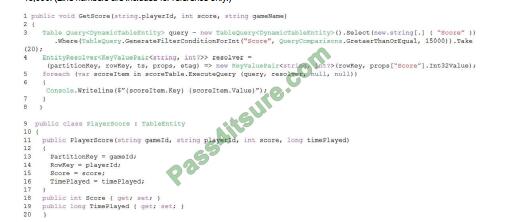
You have the following code. (Line numbers are included for reference only.)
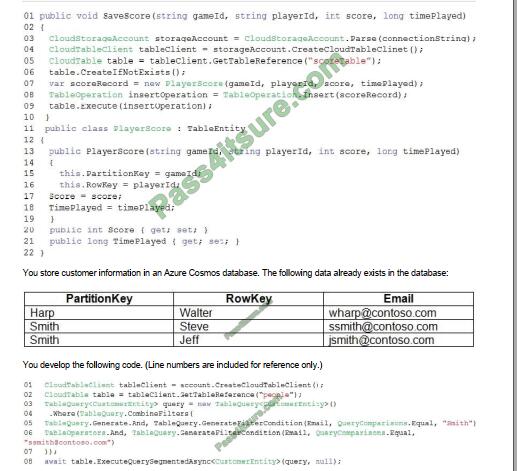
For each of the following statements, select Yes if the statement is true. Otherwise, select No. NOTE: Each correct
selection is worth one point.
Hot Area:
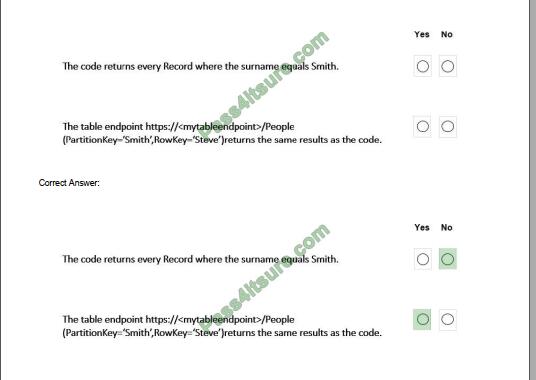
QUESTION 8
Note: This question is part of a series of questions that present the same scenario. Each question in the series contains
a unique solution that might meet the stated goals. Some question sets might have more than one correct solution,
while others might not have a correct solution.
After you answer a question in this section, you will NOT be able to return to it. As a result, these questions will not
appear in the review screen.
You are developing an Azure solution to collect point-of-sale (POS) device data from 2,000 stores located throughout
the world. A single device can produce 2 megabytes (MB) of data every 24 hours. Each store location has one to five
devices that send data.
You must store the device data in Azure Blob storage. Device data must be correlated based on a device identifier.
Additional stores are expected to open in the future.
You need to implement a solution to receive the device data.
Solution: Provision an Azure Event Grid. Configure event filtering to evaluate the device identifier.
Does the solution meet the goal?
A. Yes
B. No
Correct Answer: B
Instead use an Azure Service Bus, which is used order processing and financial transactions.
Note: An event is a lightweight notification of a condition or a state change. Event hubs is usually used reacting to status
changes.
Reference:
https://docs.microsoft.com/en-us/azure/event-grid/compare-messaging-services
QUESTION 9
After you answer a question in this section, you will NOT be able to return to it. As a result, these questions will not
appear in the review screen.
You develop and deploy an Azure App Service API app to a Windows-hosted deployment slot named Development.
You create additional deployment slots named Testing and Production. You enable auto swap on the Production
deployment slot.
You need to ensure that scripts run and resources are available before a swap operation occurs.
Solution: Update the web.config file to include the applicationInitialization configuration element. Specify custom
initialization actions to run the scripts.
Does the solution meet the goal?
A. No
B. Yes
Correct Answer: A
Specify custom warm-up.
Some apps might require custom warm-up actions before the swap. The applicationInitialization configuration element in
web.config lets you specify custom initialization actions. The swap operation waits for this custom warm-up to finish
before swapping with the target slot. Here\\’s a sample web.config fragment.
Reference: https://docs.microsoft.com/en-us/azure/app-service/deploy-staging-slots#troubleshoot-swaps
QUESTION 10
You need to authenticate the user to the corporate website as indicated by the architectural diagram. Which two values
should you use? Each correct answer presents part of the solution. NOTE: Each correct selection is worth one point.
A. ID token signature
B. ID token claims
C. HTTP response code
D. Azure AD endpoint URI
E. Azure AD tenant ID
Correct Answer: AD
A: Claims in access tokens
JWTs (JSON Web Tokens) are split into three pieces:
1.
Header – Provides information about how to validate the token including information about the type of token and how it
was signed.
2.
Payload – Contains all of the important data about the user or app that is attempting to call your service.
3.
Signature – Is the raw material used to validate the token.
E: Your client can get an access token from either the v1.0 endpoint or the v2.0 endpoint using a variety of protocols.
Scenario: User authentication (see step 5 below)
The following steps detail the user authentication process:
1.
The user selects Sign in in the website.
2.
The browser redirects the user to the Azure Active Directory (Azure AD) sign in page.
3.
The user signs in.
4.
Azure AD redirects the user\\’s session back to the web application. The URL includes an access token.
5.
The web application calls an API and includes the access token in the authentication header. The application ID is sent
as the audience (‘aud)
QUESTION 11
HOTSPOT
A company is developing a gaming platform. Users can join teams to play online and see leaderboards that include
player statistics. The solution includes an entity named Team.
You plan to implement an Azure Redis Cache instance to improve the efficiency of data operations for entities that
rarely change.
You need to invalidate the cache when team data is changed.
How should you complete the code? To answer, select the appropriate options in the answer area;
NOTE: Each correct selection is worth one point.
Hot Area:
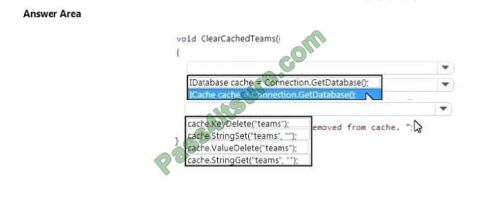
Correct Answer:
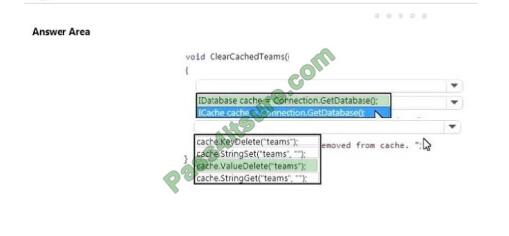
QUESTION 12
You are developing a mobile instant messaging app for a company.
The mobile app must meet the following requirements:
Support offline data sync.
Update the latest messages during normal sync cycles.
You need to implement Offline Data Sync.
Which two actions should you perform? Each correct answer presents part of the solution.
NOTE: Each correct selection is worth one point.
A. Retrieve records from Offline Data Sync on every call to the PullAsync method.
B. Retrieve records from Offline Data Sync using an Incremental Sync.
C. Push records to Offline Data Sync using an Incremental Sync.
D. Return the updatedAt column from the Mobile Service Backend and implement sorting by using the column.
E. Return the updatedAt column from the Mobile Service Backend and implement sorting by the message id.
Correct Answer: BE
B: Incremental Sync: the first parameter to the pull operation is a query name that is used only on the client. If you use a
non-null query name, the Azure Mobile SDK performs an incremental sync. Each time a pull operation returns a set of
results, the latest updatedAt timestamp from that result set is stored in the SDK local system tables. Subsequent pull
operations retrieve only records after that timestamp.
E (not D): To use incremental sync, your server must return meaningful updatedAt values and must also support sorting
by this field. However, since the SDK adds its own sort on the updatedAt field, you cannot use a pull query that has its
own orderBy clause.
References: https://docs.microsoft.com/en-us/azure/app-service-mobile/app-service-mobile-offline-data-sync
QUESTION 13
HOTSPOT
You are creating an app that uses Event Grid to connect with other services. Your app\\’s event data will be sent to a
serverless function that checks compliance. This function is maintained by your company.
You write a new event subscription at the scope of your resource. The event must be invalidated after 3 specific period
of time. You need to configure Event Grid to ensure security.
What should you implement? To answer, select the appropriate options in the answer area;
NOTE: Each correct selection is worth one point
Hot Area:
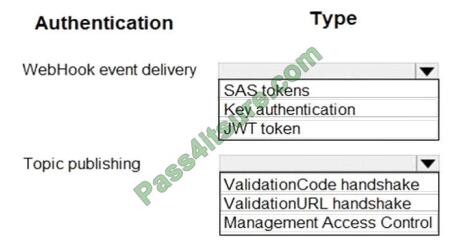
Correct Answer:
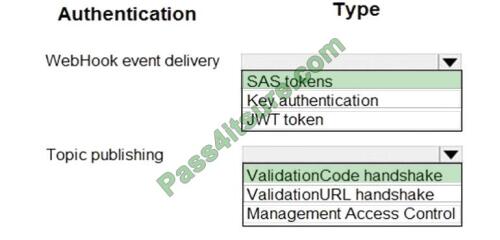
Box 1: SAS tokens
Custom topics use either Shared Access Signature (SAS) or key authentication.
Microsoft recommends SAS, but key authentication provides simple programming, and is compatible with many existing
webhook publishers.
In this case we need the expiration time provided by SAS tokens.
Box 2: ValidationCode handshake
Event Grid supports two ways of validating the subscription: ValidationCode handshake (programmatic) and
ValidationURL handshake (manual).
If you control the source code for your endpoint, this method is recommended.
Incorrect Answers:
ValidationURL handshake (manual): In certain cases, you can\\’t access the source code of the endpoint to implement
the ValidationCode handshake. For example, if you use a third-party service (like Zapier or IFTTT), you can\\’t
programmatically respond with the validation code.
References:
https://docs.microsoft.com/en-us/azure/event-grid/security-authentication
Summarize:
[Q1-Q13] Free Microsoft AZ-204 pdf download https://drive.google.com/file/d/1e8HJgdwW1CDnelD-cU0rFmJYxtx4YTMg/view?usp=sharing
Share all the resources: Latest Microsoft AZ-204 practice questions, latest Microsoft AZ-204 pdf dumps. Latest updated Microsoft AZ-204 dumps https://www.pass4itsure.com/az-204.html Study hard and practices a lot. This will help you prepare for the Microsoft AZ-204 exam. Good luck!
Related
Discover more from Exampass: Collection of Cisco (CCNA, CCNP, Meraki Solutions Specialist, CCDP...) exam questions and answers from Pass4itsure
Subscribe to get the latest posts sent to your email.
Written by Ralph K. Merritt
We are here to help you study for Cisco certification exams. We know that the Cisco series (CCNP, CCDE, CCIE, CCNA, DevNet, Special and other certification exams are becoming more and more popular, and many people need them. In this era full of challenges and opportunities, we are committed to providing candidates with the most comprehensive and comprehensive Accurate exam preparation resources help them successfully pass the exam and realize their career dreams. The Exampass blog we established is based on the Pass4itsure Cisco exam dump platform and is dedicated to collecting the latest exam resources and conducting detailed classification. We know that the most troublesome thing for candidates during the preparation process is often the massive amount of learning materials and information screening. Therefore, we have prepared the most valuable preparation materials for candidates to help them prepare more efficiently. With our rich experience and deep accumulation in Cisco certification, we provide you with the latest PDF information and the latest exam questions. These materials not only include the key points and difficulties of the exam, but are also equipped with detailed analysis and question-answering techniques, allowing candidates to deeply understand the exam content and master how to answer questions. Our ultimate goal is to help you study for various Cisco certification exams, so that you can avoid detours in the preparation process and get twice the result with half the effort. We believe that through our efforts and professional guidance, you will be able to easily cope with exam challenges, achieve excellent results, and achieve both personal and professional improvement. In your future career, you will be more competitive and have broader development space because of your Cisco certification.
Categories
2025 Microsoft Top 20 Certification Materials
- Microsoft Azure Administrator –> az-104 dumps
- Microsoft Azure Fundamentals –> az-900 dumps
- Data Engineering on Microsoft Azure –> dp-203 dumps
- Developing Solutions for Microsoft Azure –> az-204 dumps
- Microsoft Power Platform Developer –> pl-400 dumps
- Designing and Implementing a Microsoft Azure AI Solution –> ai-102 dumps
- Microsoft Power BI Data Analyst –> pl-300 dumps
- Designing and Implementing Microsoft DevOps Solutions –> az-400 dumps
- Microsoft Azure Security Technologies –> az-500 dumps
- Microsoft Cybersecurity Architect –> sc-100 dumps
- Microsoft Dynamics 365 Fundamentals Customer Engagement Apps (CRM) –> mb-910 dumps
- Microsoft Dynamics 365 Fundamentals Finance and Operations Apps (ERP) –> mb-920 dumps
- Microsoft Azure Data Fundamentals –> dp-900 dumps
- Microsoft 365 Fundamentals –> ms-900 dumps
- Microsoft Security Compliance and Identity Fundamentals –> sc-900 dumps
- Microsoft Azure AI Fundamentals –> ai-900 dumps
- Microsoft Dynamics 365: Finance and Operations Apps Solution Architect –> mb-700 dumps
- Microsoft 365 Certified: Enterprise Administrator Expert –> ms-102 dumps
- Microsoft 365 Certified: Collaboration Communications Systems Engineer Associate –> ms-721 dumps
- Endpoint Administrator Associate –> md-102 dumps

